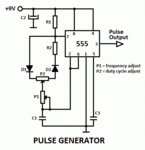farzadlatifeh
Newbie level 6
Hey there
I have an electrolysis cell to produce brown's gas from water, in the process, gas barrier decreases efficiency of cell while it may consume huge amounts of current too.
So, I need to apply PWM pulses to increase electrode efficiencies and control current consumption in one circuit.
I have this current limiter example

And this simple PWM generator

But I have no clue how to couple them in one circuit for load full control, I mean can I just use one FET in series with load that PWM circuit controls it? Is that so simple though? Or I should do some modifications to reach the target!
If anyone here can help me, I'll be really appreciated.
I have an electrolysis cell to produce brown's gas from water, in the process, gas barrier decreases efficiency of cell while it may consume huge amounts of current too.
So, I need to apply PWM pulses to increase electrode efficiencies and control current consumption in one circuit.
I have this current limiter example

And this simple PWM generator

But I have no clue how to couple them in one circuit for load full control, I mean can I just use one FET in series with load that PWM circuit controls it? Is that so simple though? Or I should do some modifications to reach the target!
If anyone here can help me, I'll be really appreciated.